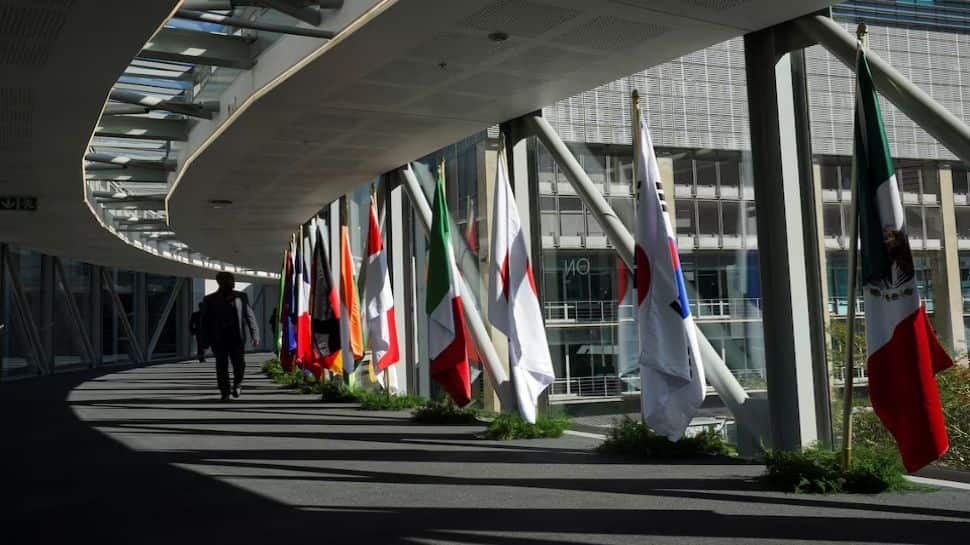Business
Lesson from China’s export restrictions: India eyes fertilizer plant project in Russia; aim to protect against supply shocks – The Times of India

Indian fertiliser companies are preparing to set up a urea manufacturing facility in Russia, a move that is likely to be announced during Russian President Vladimir Putin’s visit to India in December. This would be India’s first fertiliser venture in Russia.The plant will use Russia’s abundant ammonia and natural gas reserves, ensuring a stable supply of this key agricultural input and reducing India’s reliance on volatile global prices, according to a report by ET.State-owned Rashtriya Chemicals and Fertilisers (RCF) and National Fertilisers Ltd (NFL), along with government-backed Indian Potash Ltd (IPL), have signed a non-disclosure agreement (NDA) with Russian partners to begin planning the project, the report said.The plant is expected to produce over 2 million tonnes of urea annually. Negotiations are ongoing on land allocation, natural gas, ammonia pricing and transportation logistics.India depends largely on imports of raw materials like ammonia and natural gas for its domestic fertilizer production.The Russian facility is expected to shield India from future price shocks and supply disruptions. It will also strengthen economic ties between the two countries, which already collaborate in energy, defence and agribusiness.The project comes after India faced an acute fertiliser shortage during this year’s kharif (monsoon) season, when China temporarily halted exports of urea and other nutrients.The disruption forced India to seek supplies from other markets at higher costs, raising concerns about food production.Demand for fertilizers has gone up due to well-distributed monsoon rains. Consequently, nutrient-rich crops like maize are being grown by farmers.During the winter season, the need for urea increases even further for rabi crops such as wheat.In order to keep fertilisers accessible and affordable for farmers, they are regulated and subsidised in India, contributing to food security. The burden of government subsidies rises as global prices rise.The initial budget of Rs 1.68 lakh crore was increased to Rs 1.92 lakh crore for FY25 for the Department of Fertilisers. India’s domestic urea production hit a record 31.4 million tonnes in FY24.Despite these efforts, India still relies heavily on imports for raw materials and is the second-largest user as well as the third-largest producer of fertilizers globally.
Business
Ads for ‘misleading’ prostate supplements and home testing kits banned

Ads for prostate supplements and home testing kits have been banned over concerns they could mislead vulnerable people or steer them away from appropriate medical advice.
The Advertising Standards Authority (ASA) banned ads for four supplement brands – Nutrisslim, Nutreance, Muxue Trade and Impact Herbs – for making claims that their products could treat medical issues such as enlarged prostate, urinary flow problems or prostate inflammation.
None of the products were authorised medicines and advertising rules state that food products, including supplements, cannot make medicinal claims.
Nutreance, trading as Top 5 Supplements, said its ads did not state or imply that its product treated, cured or prevented any disease or medical symptoms, and the ads made no references to diseases, diagnoses, pathological conditions or clinical outcomes.
Nutrisslim, trading as Nature’s Finest by Nutrisslim, said the claims used in its ads related to botanical ingredients, which it understood could be used in advertising.
It said “visual materials” featuring a doctor and any related references had been removed from its website, including a reference to the product being “doctor-formulated”.
Impact Herbs, trading as Impact Supps, and Muxue did not respond to the ASA.
The ASA also banned ads from two home testing kit companies – Self Check and Lifelab Testing – for claiming that Prostate-Specific Antigen (PSA) tests could diagnose or rule out prostate cancer.
Self Check said its products were CE certified for self testing in line with UK legislation.
It further said that every product page contained a disclaimer that informed consumers that because the tests were not 100% at diagnosing a specific medical condition, they may wish to speak to their NHS GP first, who could arrange a test if needed.
It also said that it had removed the word “cancer” in the headings and descriptions of the Google ads for the product.
Lifelab also said it held the correct CE markings for an in-vitro diagnostic device, and that the product was suitable for sale in the UK.
It also said the ads had been removed and would not be used again.
A PSA test alone cannot do either, and in both cases the ads failed to make clear that these tests had limitations.
The ASA came across the ads during a sweep of healthcare claims using its AI-powered Active Ad Monitoring system.
The ASA said many of the claims it had seen in the latest investigations were “unacceptable”, and had not only broken a number of its rules but risked misleading vulnerable people, or steering those who needed it away from appropriate medical advice.
It said this was “especially worrying when it comes to men’s health”, adding that prostate symptoms could be worrying and, for some, difficult to talk about, meaning that ads promising quick fixes or simple answers “can seem even more appealing”.
However, misleading claims could give false reassurance or make it harder for people to know when to speak to a doctor, “which is why it’s so important that information about prostate health is accurate and responsible”, the ASA said.
Jess Tye, regulatory projects manager at the ASA, said: “When it comes to health, people deserve honesty.
“Misleading ads about prostate supplements or tests can cause real harm, and today’s rulings hold advertisers to account.
“We’re continuing to monitor this sector closely, using our AI tools to spot problem ads early on. And if someone does have a concern about an ad they’ve seen, we’d encourage them to get in touch.”
Joseph Burt, head of diagnostics and general medical devices at the Medicines and Healthcare products Regulatory Agency (MHRA), said: “The MHRA welcomes the ASA’s action to tackle misleading claims about PSA home-testing kits.
“At-home or over-the-counter PSA tests help members of the public monitor their prostate health, but are not a definitive test for prostate cancer. These tests must not claim to detect prostate cancer, and consumers should carefully check the labelling and read the instructions for use.
“The MHRA has recognised the expansion of over-the-counter tests, including PSA tests.
“As part of our surveillance of medical devices, we continue to monitor the safety of these devices. Manufacturers of these tests have an important role in ensuring information about direct-to-consumer tests are put into context for the general public who use these tests as well as monitoring the use of the tests.”
Amy Rylance, assistant director of health improvement at Prostate Cancer UK, said: “We are very pleased to see the ASA getting proactive in identifying and banning these dangerous and misleading adverts.
“There is no evidence that supplements can treat, cure or prevent prostate problems, and they should not be used in place of speaking to a doctor about your risk of prostate cancer, or more general concerns about your prostate health.
“While there are a range of at-home PSA self-test kits on the market currently, the accuracy and safety of these tests is not proven, and so we only recommend getting a PSA blood test from a healthcare professional.
“It’s important to remember that prostate cancer often has no symptoms in its earlier, more treatable stages, so it’s crucial for a man to understand his own risk and not to wait for potential signs or symptoms. Any men worried about their risk of prostate cancer or looking to find out more about testing can take Prostate Cancer UK’s 30-second online Risk Checker.”
Consumers can check the registration status of PSA tests via the MHRA’s Public Access Registrations Database.
Anyone concerned about the quality or safety of a PSA test should report it to the MHRA via the Yellow Card scheme.
Business
Taxpayer left with hefty bill from high UK borrowing costs – report

High government borrowing costs since Labour won the election have cost the taxpayer up to £7 billion amid concerns over the state of the UK’s finances, but this “premium” is showing signs of coming to an end, according to a report.
The Institute for Public Policy Research (IPPR) found the UK had seen “uniquely high” borrowing costs when compared to other advanced countries, with yields on government bonds – also known as gilts – having risen steadily since Labour came into power in the summer of 2024.
Yields on gilts, which move counter to the price of bonds, were up to 80 basis points higher than competitors since the election, costing the taxpayer between £2 billion and £7 billion a year, the IPPR said.
Repeated bouts of sell-offs had put gilts under pressure, it found, calculating that, at the peak, UK Government borrowing costs were six times more expensive than before the pandemic.
Former prime minister Liz Truss and her disastrous mini-budget saw gilts yields surge in September 2022 and they have come under renewed pressure over the past year as concerns over UK borrowing resurfaced.
At the recent high point, the yields on long-dated 30-year gilts had risen by 4.1 percentage points since 2022, which is 150 basis points more than the US and 100 basis points higher than for the eurozone, according to the IPPR.
The report said this was likely to have been driven by market doubts over the Government’s plans to bring down UK borrowing and whether they could be delivered.
The Bank of England also added further pressure to gilts with its programme to sell off its stock of government bonds at a faster pace than other central banks, the IPPR added.
But gilt yields have eased back in recent months – noticeably since the Chancellor’s pre-budget speech and falling further since the fiscal event on November 26, when she outlined a series of tax hikes and moves to repair the public finances.
Government borrowing is now forecast to halve over the course of this parliament.
William Ellis, senior economist at the IPPR, said: “The premium on UK borrowing costs appears to be easing, showing that markets are responding to growing confidence in the Government’s fiscal approach.”
With the UK on course to spend £92 billion on interest payments alone this year, the IPPR added that continuing declines in gilt yields could save the taxpayer “billions of pounds in reduced borrowing costs”.
Carsten Jung, associate director for economic policy at the IPPR, said: “With clear, credible fiscal plans, the UK could be a star performer in the G7 – and simply reassuring markets that we’ll stick to those plans could save billions.
“The Bank of England also needs to pull its weight. Actively selling government bonds is adding unnecessary pressure to the gilt market. It should stop – just as every other major central bank has.”
A Treasury spokesman said: ““As the Chancellor has said her fiscal rules are non-negotiable and will get borrowing down while supporting investment.
“Borrowing this year is set to be the lowest for six years as a share of GDP, we’re cutting borrowing more than any other G7 country, and we’ve doubled headroom on the stability rule to over £21.7 billion to drive costs down further.”
The Bank of England has been approached for comment.
Business
World’s Most Indebted Companies – Number One Owes More Than India’s GDP

Global Corporate Debt: Companies across the world routinely take on debt for various reasons such expanding operations, refinance existing loans or investing in growth opportunities. However, for some companies, borrowing escalates into a heavy burden when business operations fail to generate sufficient revenue. Over time, this debt can spiral, sometimes leading the firms to shut down or sell assets to stay afloat.
Examining global corporate debt reveals staggering numbers. Among the top 10 most indebted companies worldwide, five hail from China, three are from the United States, one is from France and one from Canada. The United States dominates the list with its housing finance giants.
Fannie Mae Leads The Pack
At the top of the list is American mortgage giant Fannie Mae, carrying a jaw-dropping $4.21 trillion in debt. To put this into perspective, the company’s debt is roughly equivalent to India’s GDP and exceeds the GDP of nations like the United Kingdom, France, Brazil, Italy and Canada individually.
World’s Top 10 Most Indebted Companies
In terms of corporate debt, the world’s top 10 most indebted companies are as follows:
- Fannie Mae (USA) – $4.21 trillion
- Freddie Mac (USA) – $3.349 trillion
- JPMorgan Chase (USA) – $496.55 billion
- Agricultural Bank of China (China) – $494.86 billion
- China Construction Bank (China) – $479.33 billion
- BNP Paribas (France) – $473.67 billion
- ICBC (China) – $445.05 billion
- Bank of China (China) – $400.70 billion
- CITIC Limited (China) – $386.79 billion
- Royal Bank of Canada (Canada) – $377.70 billion
India’s Most Indebted Company
Within India, Reliance Industries tops the debt charts, carrying $230.79 billion in loans. In Indian currency, this translates to an astonishing Rs 20,80,792 crore.
This highlights the scale of corporate borrowing in India, reflecting both ambitious growth plans and the complex financial strategies companies deploy to remain competitive.
This list serves as a reminder of how corporate debt, while often a tool for expansion, can also become a monumental financial challenge when not carefully managed.
-

 Sports1 week ago
Sports1 week agoIndia Triumphs Over South Africa in First ODI Thanks to Kohli’s Heroics – SUCH TV
-

 Entertainment1 week ago
Entertainment1 week agoSadie Sink talks about the future of Max in ‘Stranger Things’
-

 Fashion1 week ago
Fashion1 week agoResults are in: US Black Friday store visits down, e-visits up, apparel shines
-

 Politics1 week ago
Politics1 week agoElon Musk reveals partner’s half-Indian roots, son’s middle name ‘Sekhar’
-

 Tech1 week ago
Tech1 week agoPrague’s City Center Sparkles, Buzzes, and Burns at the Signal Festival
-

 Sports1 week ago
Sports1 week agoBroncos secure thrilling OT victory over Commanders behind clutch performances
-

 Business1 week ago
Business1 week agoCredit Card Spends Ease In October As Point‑Of‑Sale Transactions Grow 22%
-

 Entertainment1 week ago
Entertainment1 week agoNatalia Dyer explains Nancy Wheeler’s key blunder in Stranger Things 5











